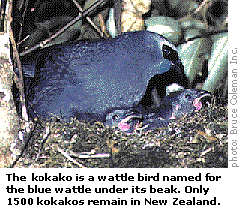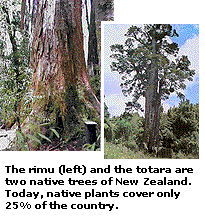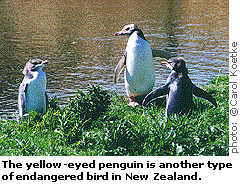| New Zealand Home |
 |
Efforts to Protect Endangered Species |
 |
|||
| It was dawn in Pureora Forest Park. I was joined by John Dobson, with the Department of Conservation. He whistled a call and an unusual-looking large blue bird appeared in the tree above us. It looked at us briefly then scuttled up higher, spread its wings, and glided away to another tree. We had just glimpsed a kokako. Kokako are wattlebirds, with two fleshy-blue flaps, or wattles, at the base of their lower beak. There used to be three types of wattlebirds in New Zealand: kokakos; saddlebacks; and huia. The huia became extinct at the turn of the century, and saddlebacks now only exist on islands around New Zealand. Only the kokako remain on the mainland of New Zealand, but even they are endangered; just 1500 kokako are left in forests of the North Island. At the Pureora Department of Conservation, workers have created a "mainland island," by clearing the area of rats, stoats, and other predators of the native birds. Without this protection, the kokako would soon be extinct too. "Many of the birds in New Zealand are poor fliers because they evolved in an environment without mammal predators," John explained. When the early settlers came, they brought rats, cats, dogs and other mammals. The native birds were devastated. A lot of the forest where the birds live was also cut down. Before people came to New Zealand, 80% of the country was native forest. Today about 25% of New Zealand is covered with native plants. Forests were cut down to make fields for cows and sheep. Native trees were used for timber and replaced with pine forests. Plants like gorse, blackberry, heather, and wild ginger have been introduced into the country and have replaced native plants in many areas. On top of this, a few hundred Australian possums were brought to New Zealand to farm for their fur. Some of these escaped and now there are 70 million possums, eating 20,000 tons of plant shoots and leaves a day. Then John showed me an area of the forest where plants and possums from other countries had been removed. He pulled aside a bush and there was a patch of small native seedlings, tiny rimu, kahikatea, and totara trees. He said that the native forest can regenerate (grow back), given the chance. Native animals can also be protected once the forest is cleared of predators. "It's a big job, but we are trying to save the special ecosystem that makes New Zealand so unique." New Zealand is one of the most beautiful, green, and least-populated countries of the world. On my journey, I have been amazed and intrigued by the life there. More importantly, though, I have seen the great effect that people have on the place where they live. What has impressed me most is that people are working to save and protect what they have around them. The Department of Conservation and volunteer groups like the Royal Forest and Bird Society are involved in looking after many special reserves around New Zealand. Saving species from extinction is not just being done to keep interesting creatures alive, though. Life on earth is a complex puzzle, where animals, plants, and the environment are all interconnected. Life and the earth are constantly changing, but today the activity of people is speeding up the rate of change. People involved in conservation are working to minimize the impact that people have on wildlife and to help maintain and restore areas that can be protected. I spoke with Ann Graeme, a conservationist with the Royal Forest and Bird Society, to learn more about conservation efforts in New Zealand. You can read my interview with Ann, in which I asked her questions students sent me by e-mail. |

|
||||



